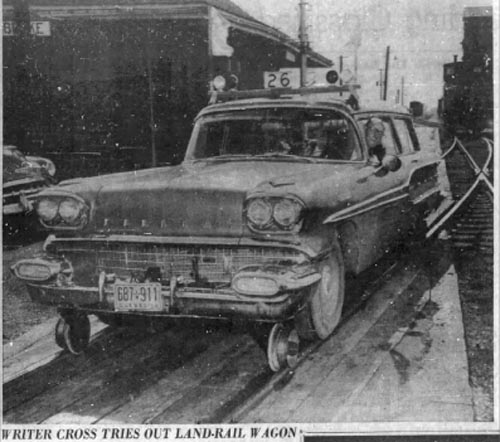
Car Can Turn Into Train, Published 29 August 1959 Straight
out of some adventure magazine seems to come Omer Boivin, general
superintendent, Montreal Division, Canadian National Railways.  In a sort of two-in-one performance, he drives a station wagon on railroad tracks on steel wheels. Then, with a twist of the wrist, he can pull up his steel wheels and drive the same car along the pavement on rubber. Super-Man Boivin has a sort of "amphibious" station wagon which enables him to cover his railway district from the Atlantic Ocean to Algonquin Park. He can also take his "train" off the Canadian National Railways at night, and drive the same car on paved streets through teeming traffic to his Montreal suburban home. Boivin produced his two-in-one by having some American-made devices added to his Canadian car. In a word, steel wheels, retractable like those on a plane. They come down at a twist of the wrist. Then the highway car becomes a railway car. Loaded down with the biggest lunch you ever saw, Mons Boivin got up early enough one recent morning to leave his private car at 5 a.m. and was at Watkley Yard before the writer got there. To make our CNR trip more comfortable, General Superintendent Boivin added human ballast in railway officialdom. "Green eye," cried Boivin to the driver, as we crossed the switch at Wass and inched out on the high iron, while the light went green for go. "No. 4 just went by, so we are clear to Pembroke," remarked Mr. Boivin, as we speeded up to 40 miles an hour, then inched cautiously across the CPR tracks ahead of the Toronto-Ottawa morning train. Next we started stopping to check every tool shed and talk to every section, foreman. "If you decide to change anything, let us know," said the super to the section foreman. "Remember, this division holds the Canadian record; let's keep it." The station wagon kept plugging away about 40 MPH. We filled the firmament with yellow feathers, as we stirred up yellowhammers and wild canaries across the lush meadows of Carleton. Once we raised some gaunt grey herons in Fitzroy swamp. We also pinked a partride (sic) perched on the rail. We crossed over into Quebec, then back into Ontario. Finally, there was station master Alphonse Redmond at Pembroke. Here we left the rails, the car hoisting its steel wheels, and rolled along in the dust on rubber. This performance put on for a few gaping onlookers, Boss Boivin ordered the rail wheels down again, and off we went. We had passed the diescl triple-headed freight at Pembroke - now we were to meet the crack Super-Continental at Achray, Mileage 242. At the same 40 MPH we wound pleasantly into the forest as we left the fields behind at Alice, and found ourselves deep in fragrant Algonquin Park. At Achray we started eating mounds of food deep in the woods under a pine tree beside a lake. It felt cool, and it was hard to realize how hot it was in Ottawa. The Super-Continental, her headlight burning at mid-day, came to a soft stop in the forest, I climbed up into the cab. Not every day does the Super make a flag stop for a newspaper man! Off to Brent went Omer Boivin and his rail and rubber station wagon. But he was back at Pembroke that evening, in time to rough it in his private car. Those who accompanied General Superintendent Boivin included Adrien des Trois Maisons, district engineers, Montreal; Alex Small, assistant superintendent, Ottawa; Carl A. Teske, roadmastcr, Beachburg Subdivision; and Bill Lashambe, secretary to the general superintendent. George Fournier, Ottawa, was the engineer on the Super Continental Limited. The fireman was Don Olmstead of Ottawa, |
![]()